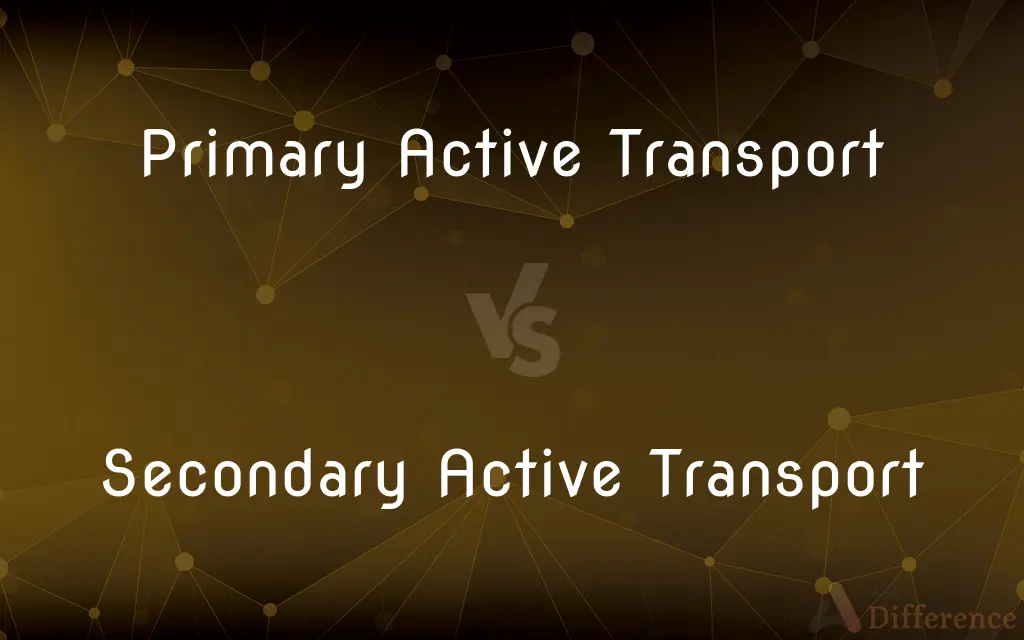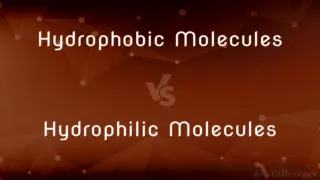Primary Active Transport vs. Secondary Active Transport — What's the Difference?
Edited by Tayyaba Rehman — By Fiza Rafique — Published on December 2, 2023
Primary Active Transport directly uses energy to transport molecules across membranes, while Secondary Active Transport uses the energy gradient established by Primary Active Transport to move molecules.

Difference Between Primary Active Transport and Secondary Active Transport
Table of Contents
ADVERTISEMENT
Key Differences
Primary Active Transport is a cellular process where molecules are transported across a cell membrane using direct energy, typically from ATP hydrolysis. This ensures molecules move against their concentration gradient. Secondary Active Transport, on the other hand, does not directly use cellular energy. Instead, it utilizes the energy gradient created by Primary Active Transport to drive the movement of molecules.
The driving force behind Primary Active Transport is often the splitting of ATP into ADP and a phosphate group, which provides the necessary energy for molecular movement. In Secondary Active Transport, the energy is sourced indirectly. It capitalizes on the potential energy set up by the Primary Active Transport to move other molecules against their own gradients.
While both types of transport systems are essential for maintaining cellular homeostasis, their mechanics are different. Primary Active Transport acts like a pump, often called "protein pumps," that requires energy to function. Secondary Active Transport, on the other hand, operates more like a gate that opens for one molecule due to the movement of another.
In conclusion, while Primary Active Transport and Secondary Active Transport both aid in the movement of molecules against concentration gradients, they differ in their energy sources. Primary uses direct cellular energy, and Secondary leverages energy gradients set by Primary.
Comparison Chart
Energy Source
Direct (e.g., ATP hydrolysis)
Indirect (uses energy gradient)
ADVERTISEMENT
Direct Involvement of ATP
Yes
No
Example
Sodium-Potassium pump
Glucose symporters
Function
Pumps molecules using energy
Transports using energy gradient set by Primary
Dependency on Other Transport Methods
Independent
Depends on energy gradients set by Primary Active
Compare with Definitions
Primary Active Transport
Directly uses cellular energy to transport molecules.
The Sodium-Potassium pump operates through Primary Active Transport by directly using ATP.
Secondary Active Transport
Essential for efficient nutrient uptake in cells.
Cells use Secondary Active Transport mechanisms to absorb nutrients from their environment effectively.
Primary Active Transport
Crucial for maintaining cellular environments.
Without Primary Active Transport, cells couldn't regulate their internal ion concentrations effectively.
Secondary Active Transport
Indirectly depends on cellular energy sources.
While not directly using ATP, Secondary Active Transport relies on the energy-consuming processes of Primary Active Transport.
Primary Active Transport
Often involves protein pumps in cell membranes.
A common example of a protein involved in Primary Active Transport is the proton pump in stomach cells.
Secondary Active Transport
Can transport multiple molecules simultaneously.
In the intestines, Secondary Active Transport can move glucose and sodium together into cells.
Primary Active Transport
Operates against concentration gradients.
Primary Active Transport helps maintain ion balance in cells by pumping ions against their gradients.
Secondary Active Transport
Does not involve direct ATP hydrolysis.
Secondary Active Transport, unlike Primary, doesn't split ATP for its operations.
Primary Active Transport
Typically reliant on ATP hydrolysis for energy.
When a cell requires specific ions inside, Primary Active Transport utilizes ATP to drive the process.
Secondary Active Transport
Utilizes energy gradients set by Primary Active Transport.
Secondary Active Transporters use the sodium gradient established by Primary Active Transport to drive glucose uptake.
Common Curiosities
What's an example of Primary Active Transport?
The Sodium-Potassium pump in cell membranes.
Is ATP directly involved in Secondary Active Transport?
No, it uses energy gradients set by Primary Active Transport.
Can you give an example of Secondary Active Transport?
Glucose symporters that use sodium gradients to absorb glucose.
Can cells function without these transport methods?
Both are crucial for maintaining cell environments and nutrient uptake.
How does Secondary Active Transport work?
It uses energy gradients set by Primary Active Transport to move molecules.
Does Primary Active Transport rely on ATP?
Yes, it often uses ATP hydrolysis for energy.
What powers Secondary Active Transport if not ATP?
The energy gradient set by Primary Active Transport.
What is Primary Active Transport?
It directly uses energy to move molecules across cell membranes against gradients.
What would happen if Primary Active Transport stopped?
Cells would struggle to maintain ion balance, and Secondary Active Transport would be affected.
Why is Primary Active Transport important for cells?
It helps maintain essential molecular gradients and cell homeostasis.
How is Secondary Active Transport related to Primary Active Transport?
Secondary uses the energy gradients created by Primary to function.
Do both transport types move molecules against their gradients?
Yes, both transport molecules against concentration gradients.
Is Primary Active Transport always linked to Secondary Active Transport?
Not always, but Secondary relies on the energy gradients set by Primary.
Which type of transport uses protein pumps?
Primary Active Transport often involves protein pumps.
Are these transport methods found in all cells?
Most cells, especially eukaryotic cells, utilize these transport methods.
Share Your Discovery

Previous Comparison
Hydrophobic Molecules vs. Hydrophilic Molecules
Next Comparison
X-Rays vs. Gamma RaysAuthor Spotlight
Written by
Fiza RafiqueFiza Rafique is a skilled content writer at AskDifference.com, where she meticulously refines and enhances written pieces. Drawing from her vast editorial expertise, Fiza ensures clarity, accuracy, and precision in every article. Passionate about language, she continually seeks to elevate the quality of content for readers worldwide.
Edited by
Tayyaba RehmanTayyaba Rehman is a distinguished writer, currently serving as a primary contributor to askdifference.com. As a researcher in semantics and etymology, Tayyaba's passion for the complexity of languages and their distinctions has found a perfect home on the platform. Tayyaba delves into the intricacies of language, distinguishing between commonly confused words and phrases, thereby providing clarity for readers worldwide.
















































